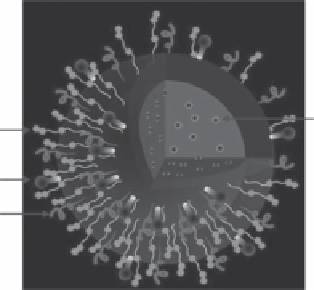Biomedical Engineering Reference
In-Depth Information
Doxorubicin
Folate
Contrast agent
PEG
figure 15.9
schematic representation of the concept of a multifunctional core-shell
nanoparticle system (plga/pFpl) composed of a plga core and a paramagnetic-folate-coated
pegylated liposome shell for Mri and drug delivery for targeted therapy. (reprinted from ref.
[166]. © Wiley.)
penetration ability, significant stability against photobleaching, and long circulation
time. polymeric nanoparticles for theranostics can also be developed based on
magnetic nanoparticles, such as paramagnetic gadolinium (gd) nanoparticles [164]
and spions [165]. as an example, copolymers of poly-(n-isopropylacrylamide)-
co
-
poly(n-acryloxysuccinimide)-
co
-poly(fluorescein
O
-methacrylate) were covalently
attached to the surface of gadolinium metal-organic framework nanoparticles [164].
The gadolinium metal-organic core allows for imaging with
T
1
Mri.
similar to dendrimers, polymeric nanoparticles can be developed to carry therapeutic
molecules either by encapsulation or bioconjugation on the surface. as such, a wide
range of drugs can be incorporated into polymeric nanoparticles, regardless of the avail-
ability of functional groups on the drug molecules. For example, liao
et al
. reported a
multifunctional nanoscale platform with a hydrophobic poly (dl-lactide-co-glycolide)
(plga) core and a hydrophilic paramagnetic-folate-coated pegylated lipid shell
(pFpl, peg), which was designed for simultaneous Mri and targeted therapeutics
[166]. hydrophobic drug DoX was loaded inside the nanostructures by encapsulation
with high loading percentage (~90%) (Fig. 15.9). The drug release study indicated
that the modification of the plga core could significantly reduce the drug release
rate. in another study, both DoX and gemcitabine (a well-known radiosensitiser)
were covalently attached to
N
-(2-hydroxypropyl)methacrylamide (hpMa) copoly-
mers via a lysosomally degradable spacer to study the synergistic effect of chemo-
therapy and radiotherapy [167].
In vivo
therapeutic study indicated that the carrier-based
radiochemotherapy was a promising approach for improving the efficacy of combined
modality anticancer therapy.
Due to the well-developed polymer chemistry, a wide variety of polymeric
nanoparticles have been developed with various sizes, surface charges, and functional
groups, allowing for different targeting strategies. Many polymeric nanoparticles can
be delivered through passive targeting, such as the DoX and gemcitabine-loaded
hpMa copolymers mentioned earlier, whereas certain polymeric nanoparticles can

Search WWH ::

Custom Search